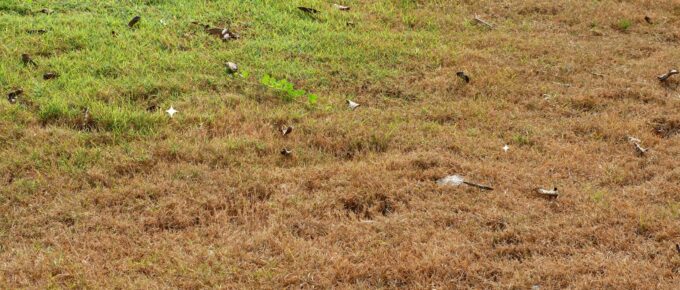Is grass affected by winter weather? Many homeowners wonder if their lawns will die during cold months or just go dormant and revive when spring arrives.
This guide provides an easy-to-understand overview of how different types of grasses are affected by winter and what you can do to help ensure that your lawn survives the season.
Is Grass Dormant in the Winter?
Depending on the type of grass, it may go dormant rather than die during cold winter months.
Dormancy is a natural process for grass that helps it rest and conserve energy until temperatures warm up. Dormant grass will look brown and dry, but its root systems are still alive and active.
You may also notice new shoots appearing when temperatures rise above freezing again in late winter or early spring.
How to Tell if Grass is Dormant
Grass goes dormant when weather, pests, or other environmental factors stress it. Here are some signs to look for to determine if the grass is dormant:
- Color: Dormant grass will typically turn brown or tan. This is because the grass has stopped producing chlorophyll, which gives it its green color.
- Texture: Dormant grass may appear thinner or sparser than healthy grass, as the blades are not growing as quickly.
- Footprints: When you walk on dormant grass, it may not spring back up immediately. Instead, footprints may remain visible for more extended periods.
- Watering: Dormant grass requires less water than healthy grass. It may be dormant if you water your lawn and it does not appear to be growing or improving.
- Growth: If your grass is not growing or growing very slowly, it may be dormant. During dormancy, grass may stop growing altogether or only grow very slowly.
It’s important to note that not all brown or tan grass is dormant.
Grass can also turn brown due to a lack of water or other environmental factors. If unsure whether your grass is dormant or dead, consult a professional landscaper or horticulturist for an accurate diagnosis.
What is the Difference Between Dormant and Dead Grass?
Dormant grass is alive, and its roots are intact, but it has stopped growing and needs water to return to life.
Dead grass has no root structure, so no watering or care will help revive it.
If your lawn looks brown and dry, test the soil for moisture before assuming it’s dead – our guide simply explains how to do this with just a few steps.
How Can You Tell if Your Lawn has Survived Through Winter?
If your lawn made it through winter in good shape, you might notice new patches of green grass appearing by mid-to-late spring and some shoots emerging from the browned stalks.
Give your lawn a few more weeks to revive fully, as it’s likely not ready for regular maintenance, such as mowing or fertilizing.
Keep an eye on any areas of concern, and contact a professional if needed.
Can You Revive a Brown Lawn After Winter?
The answer isn’t entirely clear, as it depends on the type of grass and how deeply affected it is by winter weather.
Some grass can recover partially from dormancy over winter with enough water and warmer temperatures, but some grass may die outright in extreme cases.
Whether your lawn will revive depends on how severe the cold was and what maintenance you provide before spring arrives.
Will Watering Dead Grass Bring it Back?
Unfortunately, watering dead grass will not bring it back to life. Dead grass cannot be revived by watering or any other means. If your grass is completely brown and dry, it has likely died and must be replaced.
However, if your grass is dormant, proper care and maintenance can bring it back to life. Dormant grass is simply in a state of hibernation and can be revived with regular watering and fertilization. Removing thatch or debris from the lawn can help improve air circulation and promote new growth.
To determine whether your grass is dormant or dead, perform a “tug test.” Simply grasp a handful of grass blades and gently tug on them. If the blades come out easily, the grass is dead. If the blades remain firmly rooted in the soil, the grass is likely dormant and can be appropriately revived.
In summary, watering dead grass will not bring it back to life, but watering dormant grass can help revive it. It’s essential to properly diagnose your grass’s condition before attempting any lawn care or maintenance.
What Are Some Tips for Maintaining Your Lawn During the Cold Season?
Even if your lawn goes dormant, you can still take steps to help it survive winter.
Keep up mowing and remove any dead or dying plant material. In areas with heavy snow cover, move the snow off regularly to prevent it from smothering the grass or leading to other complications like shallow freezing or disease.
You can also apply fertilizer before the cold season sets in and a winterizing fertilizer designed for cold temperatures. Finally, make sure to water your grass thoroughly before the winter arrives.



